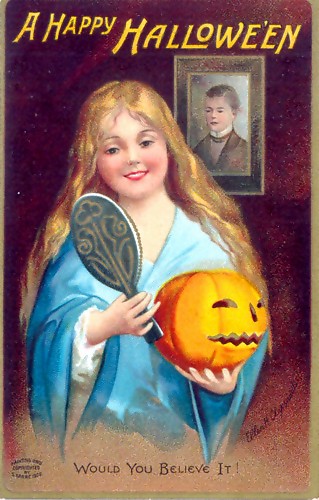
Trick-or-treating is a traditional Halloween custom for children and adults in some countries. In the evening before All Saints' Day, children in costumes travel from house to house, asking for treats with the phrase "Trick or treat". The "treat" is usually some form of candy, although in some cultures money is given instead. The "trick" refers to a threat, usually idle, to perform mischief on the homeowner(s) or their property if no treat is given. Trick-or-treating usually occurs on the evening of October 31. Some homeowners signal that they are willing to hand out treats by putting up Halloween decorations outside their doors; others simply leave treats available on their porches for the children to take freely. Houses may also leave their porch light on as a universal indicator that they have candy.

A postcard or post card is a piece of thick paper or thin cardboard, typically rectangular, intended for writing and mailing without an envelope. Non-rectangular shapes may also be used but are rare. There are novelty exceptions, such as wooden postcards, copper postcards sold in the Copper Country of the U.S. state of Michigan, and coconut "postcards" from tropical islands.
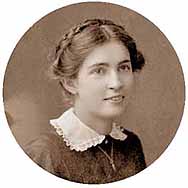
Cicely Mary Barker was an English illustrator best known for a series of fantasy illustrations depicting fairies and flowers. Barker's art education began in girlhood with correspondence courses and instruction at the Croydon School of Art. Her earliest professional work included greeting cards and juvenile magazine illustrations, and her first book, Flower Fairies of the Spring, was published in 1923. Similar books were published in the following decades.

The Japanese New Year is an annual festival with its own customs. Since 1873, the official Japanese New Year has been celebrated according to the Gregorian calendar, on January 1 of each year, New Year's Day. However, some traditional events of the Japanese New Year are partially celebrated on the first day of the year on the modern Tenpō calendar, the last official lunisolar calendar which was used until 1872 in Japan.

A Christmas card is a greeting card sent as part of the traditional celebration of Christmas in order to convey between people a range of sentiments related to Christmastide and the holiday season. Christmas cards are usually exchanged during the weeks preceding Christmas Day by many people in Western society and in Asia. The traditional greeting reads "wishing you a Merry Christmas and a Happy New Year". There are innumerable variations on this greeting, many cards expressing more religious sentiment, or containing a poem, prayer, Christmas song lyrics or Biblical verse; others focus on the general holiday season with an all-inclusive "Season's greetings". The first modern Christmas card was by John Calcott Horsley.
An E-card is an electronic postcard or greeting card, with the primary difference being that it is created using digital media instead of paper or other traditional materials. E-cards are made available many different ways, usually on various Internet sites. They can be sent to a recipient virtually, usually via e-mail or an instant messaging service.
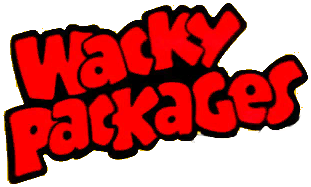
Wacky Packages are a series of humorous trading cards featuring parodies of consumer products. The cards were produced by Topps beginning in 1967, first in die-cut, then in sticker format. There were 16 series produced between 1973 and 1977, with some reprints and several new series released up to the present day.

A greeting card is a piece of card stock, usually with an illustration or photo, made of high quality paper featuring an expression of friendship or other sentiment. Although greeting cards are usually given on special occasions such as birthdays, Christmas or other holidays, such as Halloween, they are also sent to convey thanks or express other feelings.

A Christmas stamp is a postage stamp with a Christmas theme, intended for use on seasonal mail such as Christmas cards. Many countries of the world issue such stamps, which are regular postage stamps and are usually valid for postage year-round. They usually go on sale some time between early October and early December, and are printed in considerable quantities.
A special stamp is a type of postage stamp typically intended for use on special occasions and holidays that occur repeatedly. Christmas stamps, with a seasonal design, and used in vast numbers to mail Christmas cards, are the most familiar, but in recent years a number of other types have appeared.

Hoops & Yoyo are a pair of animated characters featured on Hallmark Cards. The characters were created by Bob Holt and Mike Adair on September 11, 2003, who also voice the duo. The characters have a website that features E-cards, animated episodes, an "Ask hoops & yoyo" section, desktop and phone wallpapers, audio snippets, IM icons, fan photos, interactive monthly calendars, a blog, a podcast, games, and merchandise available for purchase. The story lines center around two main characters: Hoops, a pink cat, and Yoyo, a green rabbit, and also feature a few other humorous characters joining them. Hoops and Yoyo tend to get overexcited and commonly start yelling or talking really fast. They both love coffee, cookies, and any treat. They're always happy, and always try to have fun no matter what happens.

Vinegar valentines were a type of cheeky postcard decorated with a caricature and insulting poem. A lampoon of Valentine's Day cards, the unflattering novelty items enjoyed a century of popularity beginning in the 1840s during the Victorian era.

An advertising postcard is a postcard used for advertising purposes. Postcards are used in advertising as an alternative to or to complement other print advertising such as catalogs, letters, and flyers. Advertising postcards may be mailed or distributed in other ways.

The Christmas season, also called the holiday season, or the festive season, is an annually recurring period recognized in many Western and other countries that is generally considered to run from late November to early January.

NobleWorks Inc. is an American publisher of humorous greeting cards. It publishes and sells paper greeting cards, cards with detachable magnets, lapel-button cards, gift cards, free on-line electronic greeting cards, magnetic memo pads, and note pads. The company was founded in New York, and later moved to Hoboken, and is located in Union City, in northern New Jersey.

Ellen Hattie Clapsaddle was an American illustrator/commercial artist in the late 19th and early 20th centuries. Not only is her style greatly admired and well recognized, today she is recognized as the most prolific souvenir/postcard and greeting card artist of her era.

Hallmark Cards, Inc. is a private, family-owned American company based in Kansas City, Missouri. Founded in 1910 by Joyce Hall, Hallmark is the oldest and largest manufacturer of greeting cards in the United States. In 1985, the company was awarded the National Medal of Arts.
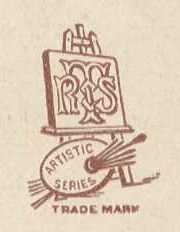
Raphael Tuck & Sons was a business started by Raphael Tuck and his wife in Bishopsgate in the City of London in October 1866, selling pictures and greeting cards, and eventually selling postcards, which was their most successful line. Their business was one of the best known in the "postcard boom" of the late 1800s and early 1900s. Their contributions left a lasting effect on most of the artistic world. During the Blitz, the company headquarters, Raphael House, was destroyed including the originals for most of their series. The company never fully recovered.

Thomas Crane (1843–1903) was an English illustrator and art director at Marcus Ward & Co. known for his colourful children's books and decorative greeting cards which often incorporated floral motifs.
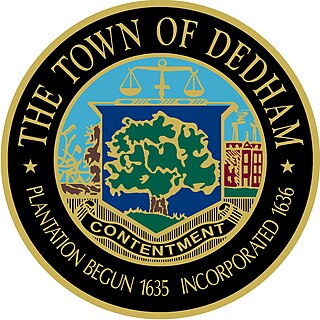
The Rust Craft Greeting Card Company was an American greeting card, printing company and owner of television stations.


